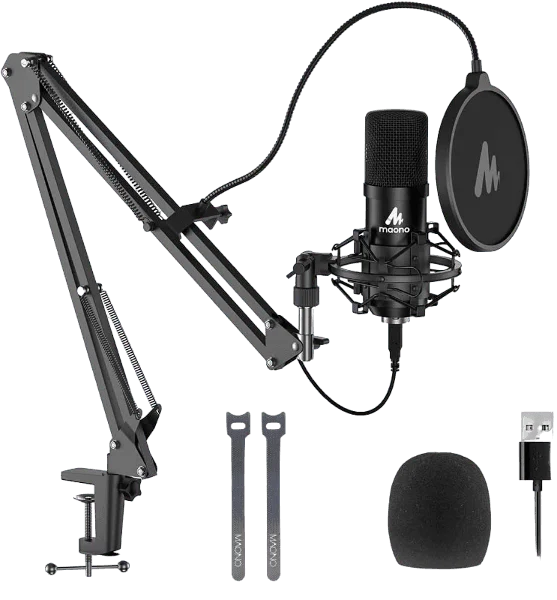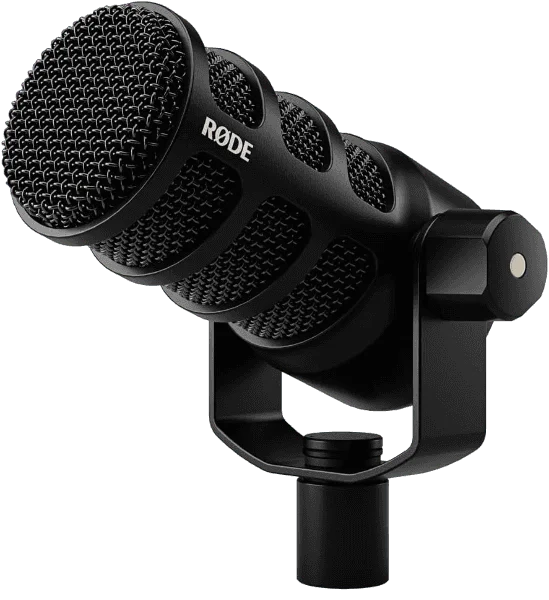In the digital age, where Microphones content creation is booming, the importance of high-quality audio cannot be overstated. Whether you’re a podcaster, musician, gamer, or streamer, the right microphone can significantly enhance your audio quality, making your content more engaging and professional. In this comprehensive guide, we will explore various types of microphones, focusing on popular options like the HyperX QuadCast 2, Amazon Basics USB Condenser Microphone, FIFINE Studio Condenser USB Microphone, and RØDE PodMic USB. We will delve into their features, and applications, and help you decide which microphone suits your needs best.
Understanding Microphones
At its core, a microphone is a device that converts sound waves into electrical signals. The choice of microphone can greatly influence the audio quality of your recordings, and understanding the types available is essential. Generally, microphones can be categorized into two main types:
- Dynamic Microphones: These are sturdy and designed to handle high sound pressure levels, making them ideal for live performances and loud sound sources. Dynamic microphones do not require external power, which adds to their convenience.
- Condenser Microphones: These microphones are more sensitive and can capture finer details, making them perfect for studio recordings, vocals, and acoustic instruments. They typically require phantom power, which is provided by an audio interface or mixer.
The Rise of USB Microphones
USB microphones have gained immense popularity due to their simplicity and ease of use. They are perfect for anyone looking to record high-quality audio without a complicated setup. Here are a few reasons why USB microphones are a great choice:
- Plug-and-Play Functionality: USB microphones connect directly to your computer, making them user-friendly for beginners and seasoned professionals alike.
- Portability: Most USB microphones are compact and lightweight, making them easy to transport for travel or remote recording.
- Affordability: Many USB microphones provide exceptional sound quality at a lower price point compared to traditional setups, making them accessible to a wide audience.
- Versatility: USB microphones can be used for various applications, from voiceovers and podcasts to music recording and gaming.
Exploring Popular Microphones
1. HyperX QuadCast 2

- GOOD FREQUENCY
- GOOD MICROPHONE
- GOOD ENHANCING
The HyperX QuadCast 2 is a standout option, particularly among gamers and streamers. Its sleek design, customizable RGB lighting, and impressive features make it a favorite in the content creation community. Here are some of its key highlights:
- Multiple Polar Patterns: The HyperX QuadCast 2 offers four selectable polar patterns—cardioid, bidirectional, omnidirectional, and stereo. This versatility allows users to tailor the microphone’s performance to different recording environments and requirements.
- Built-in Anti-Shock Mount: This feature minimizes vibrations and handling noise, ensuring that your audio remains clear and professional.
- Integrated Pop Filter: The QuadCast 2 comes with a built-in pop filter that effectively reduces plosive sounds, enhancing vocal clarity and making it ideal for podcasting and streaming.
- User-Friendly Controls: The touch-sensitive mute button is easily accessible, and a status indicator lets you know when the microphone is muted, which is particularly useful during live streams.
The HyperX QuadCast 2 is perfect for gamers and streamers who need a high-quality microphone that can adapt to various recording scenarios. Its combination of performance and aesthetics makes it a worthwhile investment for anyone serious about their audio.
2. Amazon Basics USB Condenser Microphone

- GOOD MICROPHONE
- GOOD ENHANCING
- GOOD AT VOICING
For those who are just starting or are on a budget, the Amazon Basics USB Condenser Microphone offers a practical solution. Here’s what it brings to the table:
- Plug-and-Play Design: This microphone is incredibly easy to set up—just connect it to your computer’s USB port, and you’re ready to go without any additional drivers.
- Compact and Lightweight: Its portable design makes it easy to take on the go, perfect for travel or remote recording.
- Cardioid Polar Pattern: The cardioid pattern focuses on sound from the front while minimizing background noise, making it ideal for home recording environments.
- Affordability: As one of the most budget-friendly options available, this microphone is accessible for beginners who want to get started without a significant investment.
The Amazon Basics USB microphone is an excellent choice for casual podcasters, YouTubers, and anyone looking to improve their audio quality without breaking the bank. Its straightforward setup and decent sound quality make it a great entry point into the world of audio recording.
3. FIFINE Studio Condenser USB Microphone

- GOOD VOICE
- GOOD RECOGNITION
- GOOD CONTROL
FIFINE has established itself as a reliable brand in the budget microphone market, particularly with its studio condenser USB microphone. Here are its notable features:
- High Sound Quality: With a sample rate of up to 192 kHz, this microphone captures audio with exceptional clarity, making it suitable for various recording applications.
- Cardioid Polar Pattern: This pattern effectively isolates your voice while minimizing ambient noise, ensuring a clean recording.
- Sturdy Build Quality: Constructed from durable materials, the FIFINE microphone is designed to withstand regular use, making it a dependable choice for any content creator.
- Affordability: This microphone provides great value for its price, making it a fantastic option for those looking to upgrade their audio setup without spending a fortune.
The FIFINE microphone is perfect for streamers, podcasters, and musicians who need reliable audio quality on a budget. Its performance and durability make it a solid investment for emerging creators.
4. RØDE PodMic USB Versatile Dynamic Broadcast Microphone

- GOOD FREQUENCY
- GOOD SOUND QUALITY
- GOOD AT LEVEL
The RØDE PodMic is specifically designed for podcasters and broadcasters who demand high-quality sound. Here’s an overview of its features:
- Dynamic Microphone Design: The PodMic is known for capturing rich, warm vocals, making it ideal for voice applications.
- USB and XLR Output: This flexibility allows you to connect the microphone directly to a computer via USB or to an audio interface using XLR, accommodating various recording setups.
- Built-in Pop Filter: The integrated pop filter reduces plosive sounds, ensuring clarity in your recordings, which is essential for professional-quality audio.
- Robust Construction: Built to endure the rigors of both studio and live environments, the RØDE PodMic is a durable choice for content creators.
The RØDE PodMic stands out as a professional option for podcasters looking to elevate their audio quality. Its versatility, combined with its high-quality sound, makes it a worthy investment for serious creators.
5. USB Microphone Review

- EXTRA ORDINARY
- EXTRA MUSHUP
- GOOD QUALITY
USB microphones have become a staple for content creators, podcasters, and gamers looking for an easy and efficient way to achieve high-quality audio. One of the standout features of USB microphones is their plug-and-play functionality; simply connect them to your computer, and you’re ready to record without the need for additional equipment or complex setups.
Many USB microphones, such as the Amazon Basics USB Condenser Microphone and FIFINE Studio Condenser, offer excellent sound quality at an affordable price, making them ideal for beginners. They typically feature cardioid polar patterns that focus on sound from the front, minimizing background noise—a crucial factor for home recording environments.
While they are generally less expensive than traditional XLR setups, USB microphones can still deliver impressive performance. However, for advanced users, options with XLR outputs, like the RØDE PodMic USB, provide additional versatility for professional setups.
In summary, USB microphones are an excellent choice for anyone looking to produce quality audio without the hassle. Their ease of use, portability, and affordability make them a popular option for both novice and experienced creators. If you’re diving into audio production, a USB microphone is a great starting point.
4o mini
Comparing the Microphones: Which One Is Right for You?
Choosing the right microphone ultimately depends on your specific needs, budget, and intended use. Here’s a comparison of the highlighted microphones to help you make an informed decision:
| Feature | HyperX QuadCast 2 | Amazon Basics USB Microphone | FIFINE Studio Condenser | RØDE PodMic |
|---|---|---|---|---|
| Type | USB Condenser | USB Condenser | USB Condenser | Dynamic (USB & XLR) |
| Polar Patterns | 4 (Cardioid, etc.) | Cardioid | Cardioid | Cardioid |
| Price Range | Moderate | Budget | Budget | Moderate to High |
| Build Quality | High | Moderate | High | High |
| Ideal Use | Gaming/Streaming | Casual Recording | Beginner to Intermediate | Podcasting/Broadcasting |
Conclusion: Finding Your Perfect Microphone
In the diverse world of microphones, there’s an ideal option for everyone, from hobbyists to professionals. The HyperX QuadCast 2 offers versatility and style for gamers and streamers, while the Amazon Basics USB Condenser Microphone serves as an excellent entry-level option. The FIFINE Studio Condenser USB Microphone strikes a balance between affordability and sound quality, making it a favorite for beginners. Finally, the RØDE PodMic is a premium choice for those serious about their audio quality.
When selecting a microphone, consider your specific recording needs, budget, and environment. The right microphone can significantly enhance your audio quality, making your content more engaging and professional.
Tips for Choosing the Right Microphone
- Identify Your Use Case: Consider what you will primarily use the microphone for—different applications may require different features and specifications.
- Assess Your Recording Environment: A microphone with a cardioid pattern will help reduce background noise if you’re recording in a noisy area. In quieter settings, you may have more flexibility.
- Test Before You Buy: If possible, try out microphones in-store or check online reviews and sound samples. Listening to the microphone in action can help you make a more informed choice.
- Consider Accessories: Consider whether you need additional accessories like a pop filter, boom arm, or shock mount. These can enhance your recording quality and usability.
- Budget Wisely: While it can be tempting to opt for the cheapest option, investing in a higher-quality microphone can yield better results in the long run.
By carefully considering your options and selecting the right microphone for your needs, you can significantly improve your audio quality and elevate your content creation to new heights. Happy recording!
What’s the difference between dynamic and condenser microphones?
Dynamic microphones are rugged and handle high sound pressure levels, making them ideal for live performances and loud sound sources. They don’t require external power and are generally less sensitive to background noise. Condenser microphones, on the other hand, are more sensitive and capture a broader range of frequencies, making them suitable for studio recording, vocals, and acoustic instruments. They typically require phantom power, which is provided by an audio interface or mixer.
2. Do I need an audio interface for a USB microphone?
No, you do not need an audio interface for a USB microphone. USB microphones connect directly to your computer via a USB port, allowing for easy plug-and-play functionality. This makes them accessible for beginners and convenient for home recording setups. However, if you choose an XLR microphone, you will need an audio interface or mixer to connect it to your computer.
How do I choose the right microphone for my needs?
To choose the right microphone, consider your intended use. For podcasting or vocals, a condenser microphone with a cardioid pattern is often preferred for its sensitivity and clarity. For live performances or instruments, a dynamic microphone may be more suitable. Additionally, think about your budget, recording environment, and whether you need portability. Testing microphones in-store or listening to online reviews can also help you make an informed decision.

